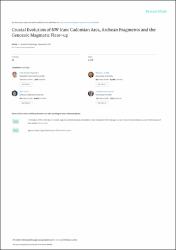Crustal evolution of NW Iran: Cadomian arcs, archean fragments and the cenozoic magmatic flare-up

Göster/
Erişim
info:eu-repo/semantics/openAccessTarih
2017Yazar
Moghadam, Hadi ShafaiiGriffin, William L.
Li, Xian-Hua
Santos, Jose F.
Karslı, Orhan
Stern, Robert J.
Ghorbani, Ghasem
Gain, Sarah
Murphy, Rosanna
O'Reilly, Suzanne Y.
Üst veri
Tüm öğe kaydını gösterKünye
Moghadam, H.S., Griffin, W.L., Li, X.H., Santos, J.F., Karslı, O., Stern, R.J., Ghorbani, G., Gain, S., Murphy, R. & O'Reilly, S.Y. (2017). Crustal Evolution of NW Iran: Cadomian Arcs, Archean Fragments and the Cenozoic Magmatic Flare-Up. Journal of Petrology, 58(11), 2143-2190. https://doi.org/10.1093/petrology/egy005Özet
The Cadomian orogen of NW Iran includes a series of metamorphic rocks with zircon U-Pb ages between ca 562 and 505 Ma (Ediacaran to middle Cambrian). the Ediacaran-Cambrian basement is intruded by a series of Late Eocene-Late Oligocene I-type granitic rocks. U-Pb geochronology, integrated with geochemical and isotopic data for the basement rocks in NW Iran, provides further evidence of a Cadomian (562-505 Ma) arc-related magmatic event lasting similar to 60 Myr. Cadomian magmatism in Iran was a part of a similar to 100 Myr long episode of subduction-related arc magmatism at the northern margin of Gondwana. Zircon Hf-isotope compositions show that during Cadomian magmatic arc activity, juvenile arc magmas interacted with reworked Archean crust to generate the Ediacaran-Cambrian igneous rocks. Our results document both inheritance of old zircons and the presence of zircons with juvenile signatures in NW Iran, suggesting that the geotectonic setting for the Cadomian rocks was an Ediacaran continental magmatic arc and probably a neighboring back-arc basin. the occurrence of Ediacaran ophiolitic slices in NW Iran may provide evidence of back-arc basin opening at that time. Cenozoic plutonism in NW Iran is part of an Eocene-Oligocene magmatic 'flare-up' along the Urumieh-Dokhtar Magmatic Belt in central Iran, which lasted for ca 30 Myr. the melts responsible for the formation of these rocks had an essentially juvenile signature with minor contamination by Archean to Cadomian middle-lower continental crust. Continuous convergence between Arabia and Iran was accompanied by the transition of SW Eurasia from a compressional to an extensional convergent plate margin in Eocene-Oligocene times, leading to orogenic collapse, core-complex formation, exhumation of Cadomian crust and a major increase in arc magmatism.

















